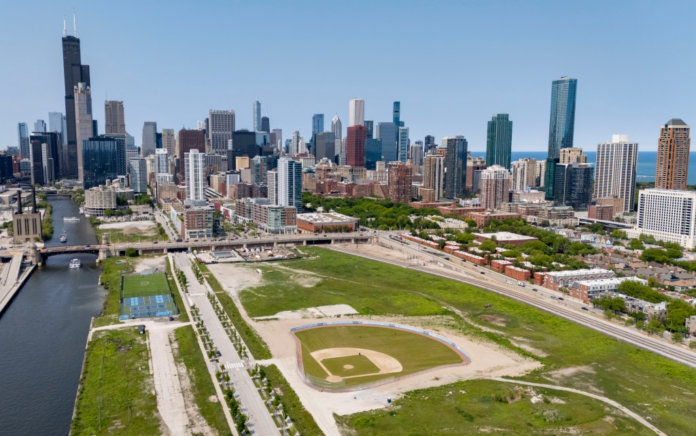It’s moving season in Chicago.
The Bears, Fire and White Sox are in the market for new homes, while the Blackhawks and Sky eye expanding their footprint in the city.
“There’s no reason to leave Chicago if you’re a sports team. There isn’t,” Chicago Mayor Brandon Johnson said. “There’s just too much soul in this city to leave it now.”
Here’s what to know about the teams’ various plans — and various levels of readiness to pack it up.
Bears
Current home: Soldier Field (since 1971)
Possible future home: New domed stadium in Arlington Heights
The Bears are shifting their focus from Chicago to a new stadium in Arlington Heights, a project that would depend on state legislation allowing for negotiated financing of large-scale development projects.
Construction of a new suburban stadium would generate thousands of jobs and billions of dollars in economic activity, but would also require substantial taxpayer support for infrastructure, according to team projections released on Sept. 30.
The Bears purchased the land in Arlington Heights — formerly the 326-acre Arlington International Racecourse — in February 2023, hoping to build a new enclosed stadium with a massive entertainment and residential development. In April 2024, the team laid out elaborate plans for a new publicly owned domed stadium on the Chicago lakefront but left unanswered how the city would pay for expensive infrastructure improvements.
Illinois lawmaker introduces bill that could hinder Bears’ move to suburb as legislative session begins
Bears face a long drive to get passage of stadium legislation in the fall
As Bears pivot to Arlington Heights, Mayor Brandon Johnson says ‘I’ve done my part’
What to know about the Bears’ possible move from Soldier Field to suburban Arlington Heights
Fire
Current home: Soldier Field (since 2020)
Possible future home: New stadium in South Loop
The Fire unveiled detailed renderings of their proposed privately funded $650 million open-air soccer stadium at The 78 in the South Loop. The facility is meant to look like it has been part of the city’s sports landscape for a century.
Situated along the Chicago River, the intimate 22,000-seat, red brick stadium would feature a natural grass pitch, a steel roof and a plethora of premium options to go with traditional supporter sections and general admission seating.
The Chicago City Council approved owner Joe Mansueto’s plan on Sept. 26 — the last major hurdle before construction crews could break ground.
The project would not require public funding, Mansueto told the Tribune. The team is scheduled to break ground on the new stadium as early as this fall, with a target completion date ahead of the 2028 MLS season.
Designed by architectural firm Gensler, the stadium seeks to provide the Fire with a “world-class home” and catalyze a Wrigleyville-like development at the mostly vacant 62-acre site south of Roosevelt Road. It purposely evokes a similar vintage look to the longtime Cubs home. There would be about 2,000 parking spots available at The 78. Fans also could take the CTA to the stadium; there’s a nearby “L” station and multiple bus lines. Taking a water taxi is another possibility.
Chinatown residents express aspirations — and concerns — for proposed Chicago Fire stadium
Fans at Soldier Field doubleheader see Fire and Stars’ potential new homes having an impact on Chicago soccer
White Sox
Current home: Rate Field (since 1991)
Possible future home: New stadium in South Loop
The White Sox said they’re still considering building their proposed new ballpark at the South Loop site as well, potentially creating a new pro sports nexus in Chicago.
At least one industry analyst said shoehorning two new stadiums into the 62-acre site is not only viable, but potentially a boon for both teams and the city. Last year the Sox proposed a new publicly funded ballpark at The 78, but Springfield lawmakers balked at the idea of contributing a reported $1 billion to build it.
“It could work,” said Marc Ganis, a Chicago-based sports marketing consultant. “They would have to work out the use of the infrastructure and the parking and scheduling and things of that nature. I think it’d be great for the city.”
Building adjacent stadiums is gaining traction in several markets, including Arlington, Texas, where the Dallas Cowboys play at AT&T Stadium and the Texas Rangers are a line drive away at Globe Life Field. In the Los Angeles area, SoFi Stadium in Inglewood, where the Rams and Chargers play football, is next door to the Intuit Dome, the new basketball home of the Clippers.
It remains to be seen whether the Sox would be able to get the financial and political support to move.
In 1988, Sox Chairman Jerry Reinsdorf pushed through legislation to fund a new baseball stadium after threatening to move the team to Florida. Built in 1991, the stadium, now called Rate Field, was primarily funded through the issuance of $150 million in hotel-tax-supported bonds by the Illinois Sports Facilities Authority.
The Sox lease at Rate Field runs through 2029 and the ISFA still owes $50 million on the ballpark.
Column: Did the Fire just call dibs on The 78? Or are the White Sox’s ballpark dreams still alive?
Jerry Reinsdorf reaches deal to sell White Sox to Justin Ishbia — but not until 2029 at the earliest
Stars
Current home: SeatGeek Stadium (since 2016)
Possible future home: Martin Stadium in Evanston
The Stars will depart their usual Bridgeview venue to play a “test run” game at Northwestern’s Martin Stadium in September as they consider a permanent move there. Fans nearly filled the 12,000-capacity stadium in the 2-1 win, which brought an increased amount of noise whenever the team scored a goal. The official attendance was 10,127, the highest number for the Stars this season.
The ultimate goal for the Stars is to one day play in the team’s own stadium, but President Karen Leetzow believes the club has landed on an intriguing new option for now as she announced the 2026 season will be played at Martin Field.
“It is incredibly accessible,” Leetzow said on Sept. 4. “It’s in a terrific community that is very supportive of women’s sports. It’s close to a built-in fan base with university students. It’s just got all the things you could possibly want for these athletes.”
Stars and Sky push for equality in public stadium funding for men’s and women’s sports in Illinois
Stars join the teams seeking public funding for a stadium: ‘Women’s sports need to have a seat at the table’
Blackhawks
The Blackhawks gave a sneak peek at the Fifth Third Arena expansion — still a skeletal collection of steel beams, HVAC systems and construction dust.
While Hawks players will continue to use the same two rinks they’ve used for practices and training camps since Fifth Third opened in 2017 just south of the United Center, the United States Hockey League’s Chicago Steel will play home games at one of two new rinks — the one the Hawks are calling Championship Arena.
It will seat 1,500 and host up to 2,000, with the building also including lounges, a fan patio with a skyline view, a restaurant named after late Hawks Chairman Rocky Wirtz and a 100th anniversary museum called Centennial Hall, which also will house the new Blackhawks Hall of Fame.
The privately funded expansion, which began in May 2024 and is scheduled to be completed in January 2026, initially was projected to cost $65 million, but a source told the Tribune it likely will land “significantly higher.”
It also augments the 1901 Project, the Hawks’ and Bulls’ 15-year, $7 billion United Center campus development plan that will feature new residences, hotels and an entertainment district.
Hawks Chairman/CEO Danny Wirtz noted how much has changed since the Hawks and Bulls moved from Chicago Stadium to the United Center. But as any Hawks or Bulls fan knows, once the game is over, the area can feel rather barren, bracketed on all sides by parking lots.
“We’re sitting on a lot of parking lots, right?” Wirtz said. “And we see parking has continued to decrease with other modes (of transportation) to get here. We’re absolutely thinking about what the future could look like.”
Blackhawks’ planned Fifth Third Arena expansion is likely just the first of Near West Side projects
Sky
The Chicago Sky were in a celebratory mood on Sept. 18.
Members of the front office and basketball staff gathered in Bedford Park alongside members of the village government to sign one of the final beams used in the construction of the team’s new training facility. It marked the first time that many members of the Sky — including coach Tyler Marsh — had seen any of the construction on the project.
But while the Sky were eager to celebrate progress, the team faces a crucial question of timing: Will the training facility be ready for the 2026 season? Even with significant delays, executives from both the Sky and the Village of Bedford Park believe the answer is yes.
“I am confident that it will be done before the season next year,” Sky co-owner and operating chairman Nadia Rawlinson said.
The $38 million facility originally was expected to be completed in October 2025. With their $5.9 million front-end payment in 2024, the Sky would secure a 10-year deal to occupy a 43,000-square-foot portion of the 125,000-square-foot facility constructed in Phase 2 of the Wintrust Sports Complex project. After 10 years, the Sky would have an option to renew for another decade.


